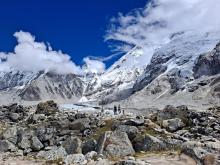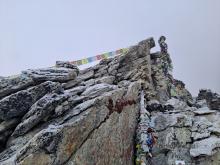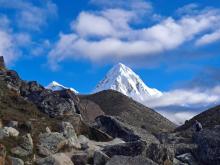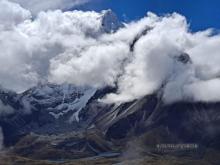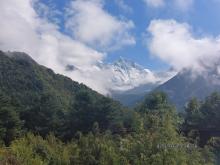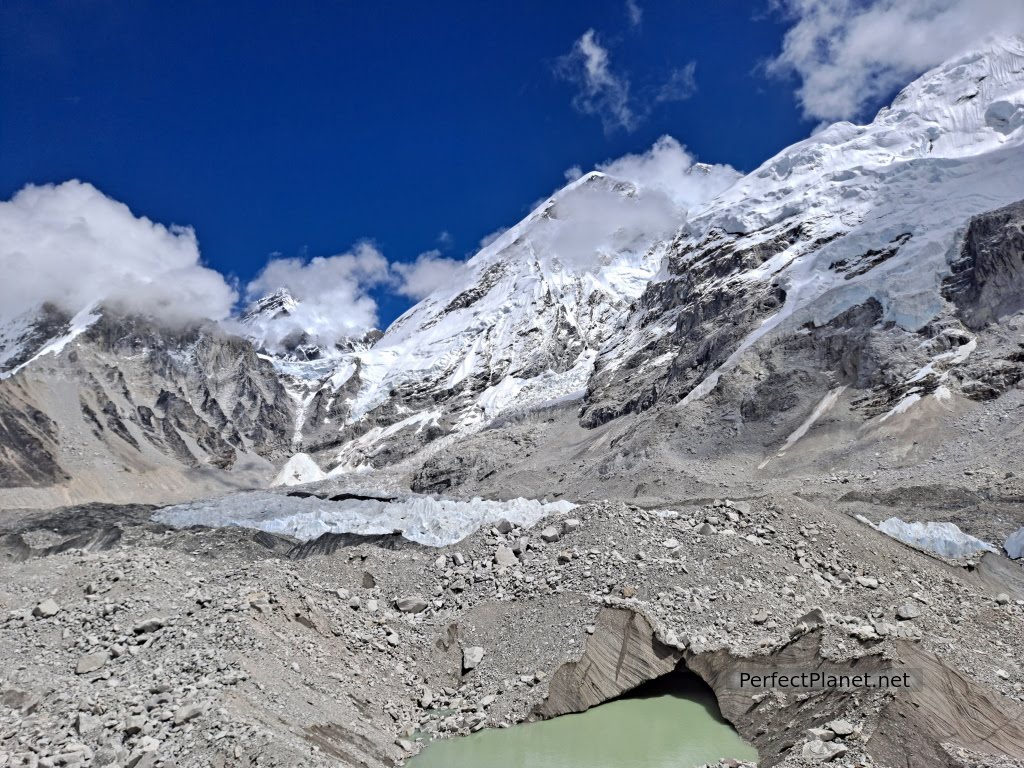
EBC
You may be interested in Nepal.Practical Information
and/or Budgeting for the EBC trek, tips for saving money
When we talk about the EBC Trek we are talking about one of the most popular trekking routes in the world and no wonder.
Walking the same paths as Hillary and Norgay, the first climbers to summit the highest mountain in the world, Mount Everest, is a dream. To live for several days surrounded by eight-thousanders, endless glaciers, crossing bridges suspended over rivers that roar in their wake, heat and cold, rain, sun and snow, remote villages in hidden valleys, Sherpa culture and the ever-looming altitude sickness.
A dream come true for us and for thousands of people who every year join this wonderful experience in which mountain and nature lovers enjoy and suffer in equal parts.
Trekking on your own or with a guide
Trekking backpack to EBC trek, the essentials
The best time to trek the EBC is April and May in spring and mid-September to November in autumn. The rest of the year most lodges are closed and weather conditions are difficult. From June to August the monsoon is present throughout the country with widespread heavy rains. In winter the weather becomes very cold and the likelihood of heavy snowfall increases.
We trekked at the end of the monsoon in the second half of September and the weather was fine except for the last day when we walked for 8 hours in constant rain.
April and May are the busiest months as the trekking coincides with the Everest expeditions.
October and November are cooler but with sunnier days offering incredible views.
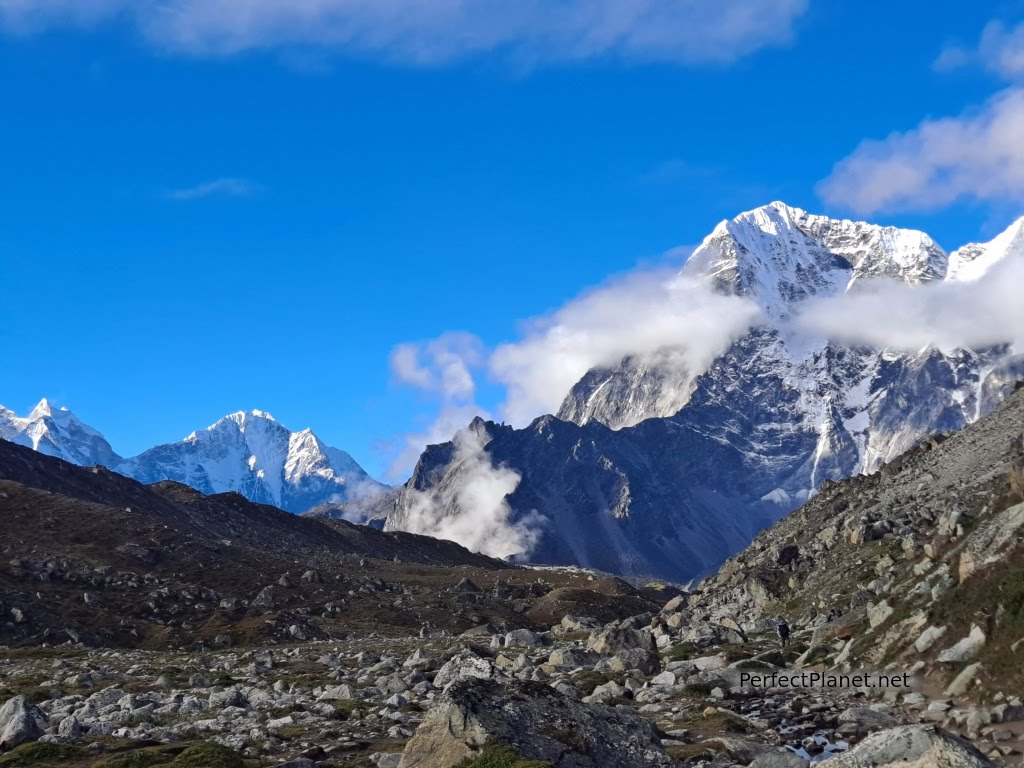
Nuptse
Trekking on your own or with a guide
From 01 April 2023 the Nepalese government made it compulsory to trek in Nepal with an authorised guide. However, this obligation does not extend to all treks in the country, so if you want to do the EBC trek on your own, you can do so.
We hired a guide and a porter (due to Joaquín's back problems) with the company Rutas Nepal, a Nepalese agency run by Dipendra, and we are delighted.
It is not necessary to hire a porter, everything will depend on your physical condition, although it is advisable, as the weight in height is noticeable. Remember that even if you hire a porter they are also people, the backpack should not weigh more than 12 or 15 kilos, they also have to carry their own backpack with their personal belongings.
Our guide Sonam and our porter Chiiring have been two essential people in our trip, without them it would not have been the same. In our case we hired the simplest package including flight by plane from Kathmandu, accommodation and meals, guide and porter for €1,035/pax. An excellent price compared to the other agencies we consulted, starting at €1,400/pax.
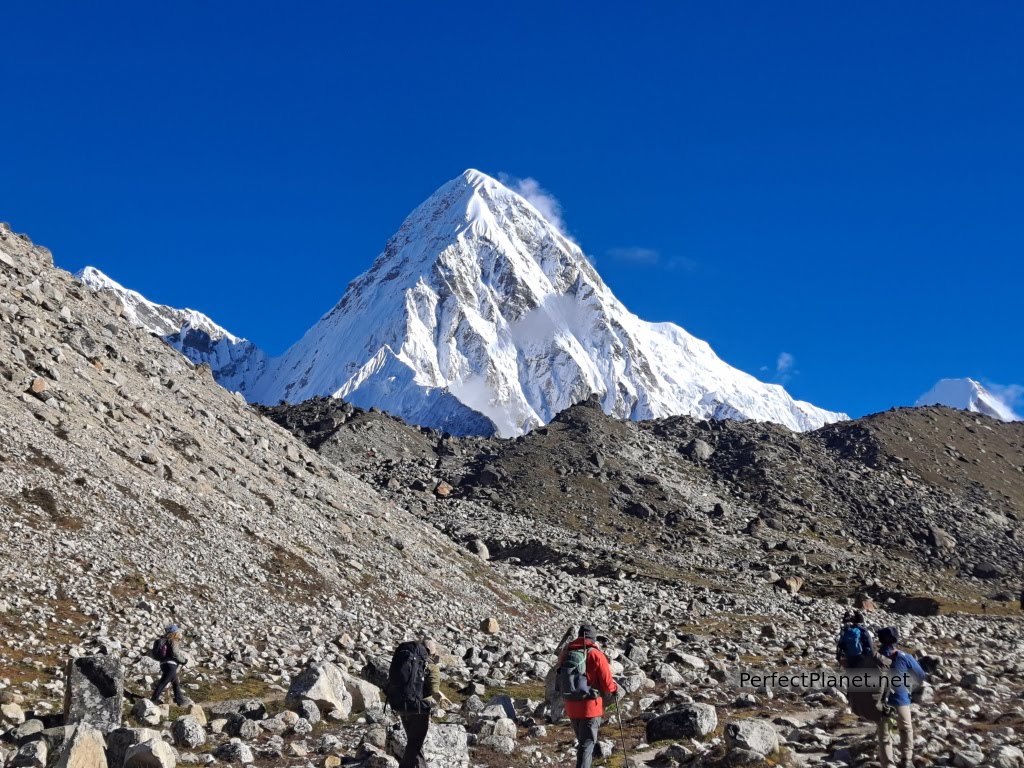
Pumori
Trekking on your own
If you decide to do it on your own, remember the following tips:
1. Book accommodation for the trek in advance, it is almost obligatory especially in high season, the demand is higher than the supply and you can find yourself without accommodation having to sleep in the street with low temperatures, remember that we are talking about high mountains.
2. Book your flight to Lukla well in advance. The main companies are Jeti, Sita or Tara air. Until 25 September flights usually depart from Kathmandu airport, after that date flights depart from Ramechap airport, 4 hours by private car from Kathmandu, the price is around 50€/pax/trip, a van is around 26€/pax/trip and can take between 5 and 7 hours. You can also get there by public bus from the Jadibuti bus stop (east of Kathmandu), only a good option if you're spending the night in Manthali and catching your flight the next day. It costs about $6/pax/way and takes about 8 hours.
Another option is to fly by helicopter from Kathmandu to Lukla. This is the most expensive option of all, costing around $400/pax/trip. When weather conditions are bad, light aircraft can't fly but helicopters can, so it's sometimes the only option when time is short.
3. Don't carry more than 10 kilos in your backpack. Prepare your backpack in detail, it is essential not to carry unnecessary weight in order to suffer as little as possible on a daily basis. We help you to prepare your backpack in the following link EBC Trekking Backpack, clothes and essential material.
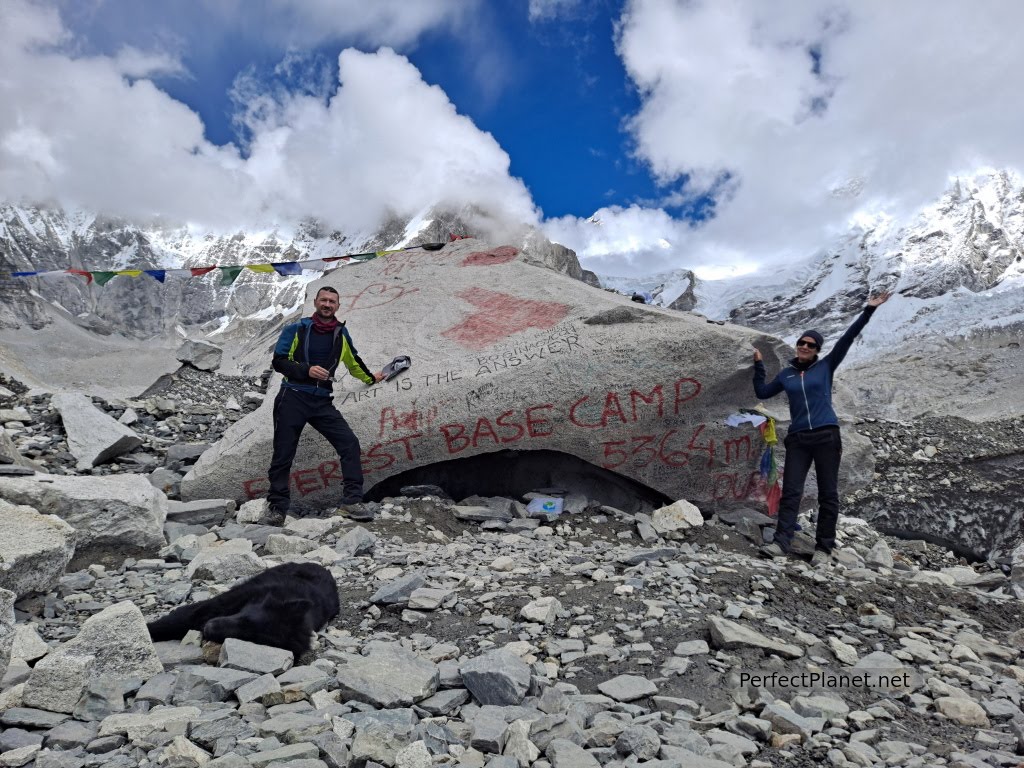
EBC
How to get Lukla
To get to Lukla you have two options, flying by plane and/or helicopter or walking from Jiri.
1. Flights to Lukla. Tenzing-Hillary Airport in the small town of Lukla is considered one of the most dangerous airports in the world. It is at an altitude of 2,860 metres, has a single runway measuring 450 metres long and closes at 12pm every morning as weather conditions make it difficult for light aircraft to manoeuvre after that time. Pilot skill is essential at this type of airport, where only 12-seater aircraft can fly in. It also has a heliport.
From Kathmandu
Book your light aircraft flight to Lukla well in advance. The main airlines are Jeti, Sita or Tara air. A flight from Kathmandu to Lukla can cost up to €200 in high season and takes about 35 minutes.
From Ramechap
Until 25 September flights usually depart from Kathmandu airport, after that date flights depart from Ramechhap airport. To get to Ramechap you have two options, private car or bus. By private car from Kathmandu it takes about four hours, the price is around 50€/pax/trip, a van is around 26€/pax/trip and can take between 5 and 7 hours. By public bus, which leaves from the Jadibuti bus stop (east of Kathmandu), is only a good option if you're spending the night in Manthali and flying out the next day. It costs about $6/pax/way and takes about 8 hours.
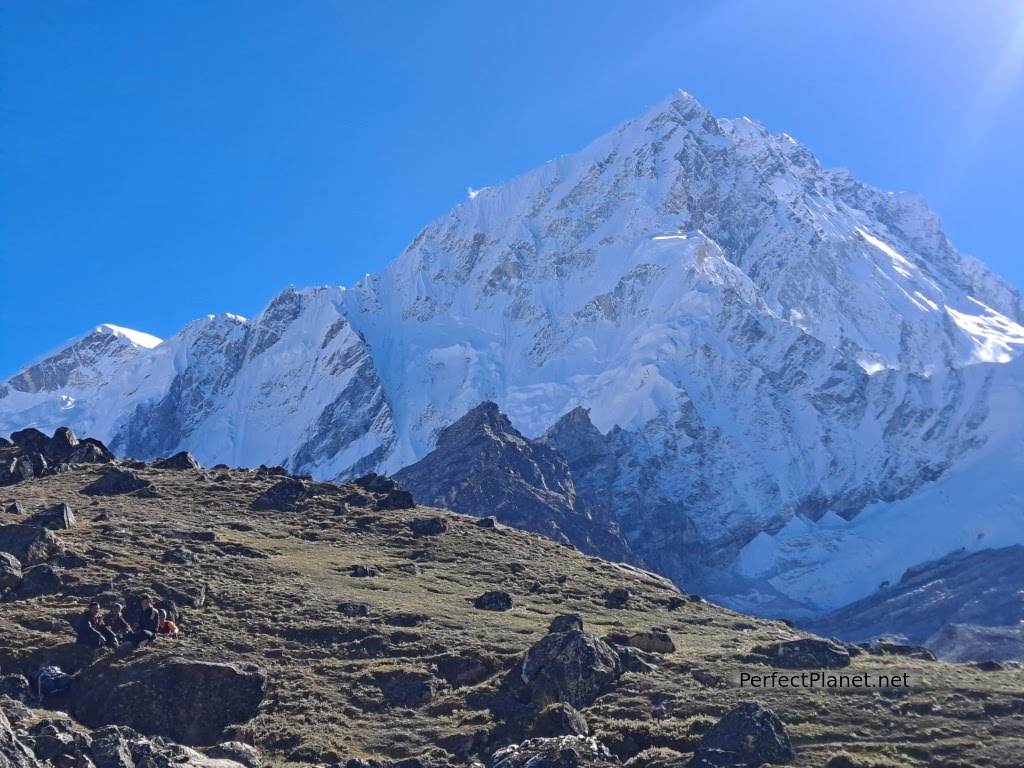
Nuptse
Another option is to fly by helicopter from Kathmandu to Lukla. This is the most expensive option of all, costing around $400/pax/trip. When weather conditions are bad, light aircraft can't fly but helicopters can, so it is sometimes the only option when time is short.
We had no problems getting to and from Lukla by light aircraft. The only downside was that our flight was late - it was scheduled for 6am and we flew at 9.30am. We were very lucky because there were several groups that had been waiting several days to fly without success and thanks to the helicopter we were able to leave. If you travel with an agency this is a possibility that you have to negotiate with them, they should not charge you the price of the plane if you finally have to take the helicopter.
According to what we were told, depending on the flight company you choose, there seem to be preferences when it comes to the flights.
2. Walking from Jiri
If you don't want to get to Lukla by plane, you have the option of walking from Jiri (8 hours by bus from Kathmandu). This means you have to add at least 4 days to the trek, so if you have enough time it's a good option, you avoid the hassle of flying by plane and it's cheaper.
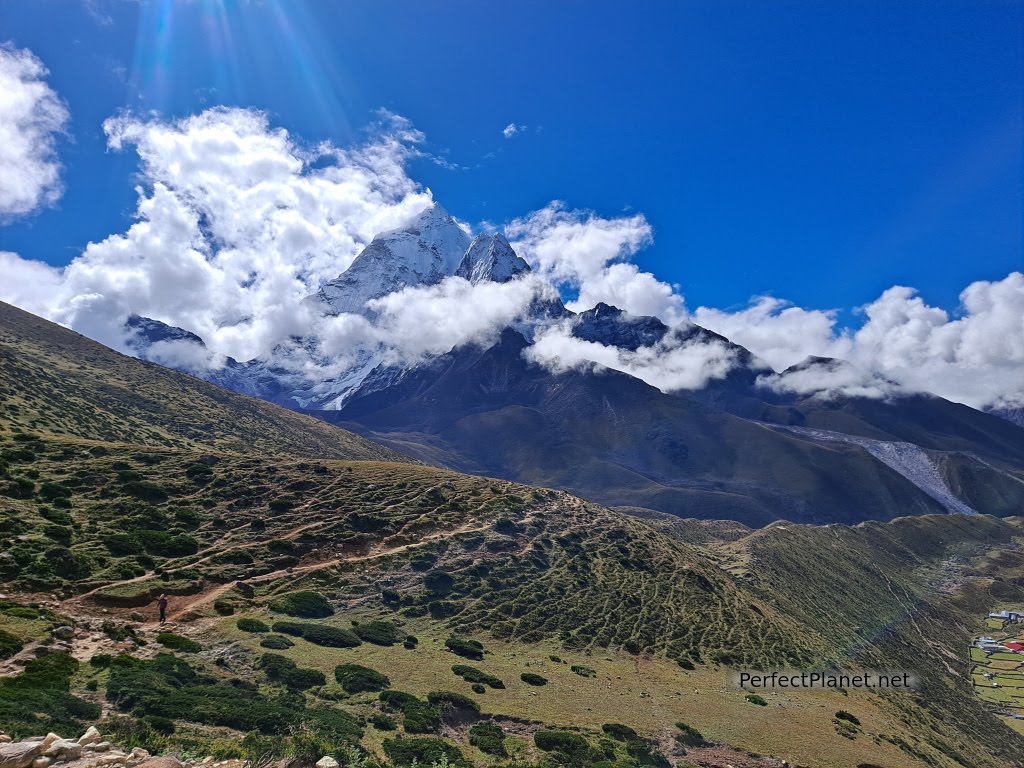
Ama Dablam
Trekking to EBC, tour
To reach the EBC you have several alternatives, we chose the classic route from Lukla but if you have more days and a good physical condition you have other options within the spectacular Sagarmatha National Park (Nepalese name for Everest).
Classic EBC trekking route (12 days). It starts in Lukla at 2,860 metres. During 12 days we go up the Khumbu valley. We stay in the villages of Phakding (2,640 metres), Namche Bazaar (3,410 metres) where we spend a day acclimatising up to Khumjung (3,900 metres) with views of Ama Dablam (6,814 metres), Lhotse Shar (8,382 metres), Thamserku (6,618 metres) and Everest (8,848 metres); Tengboche (3,860 metres), Dingboche (4,410 metres) where we will spend a day acclimatising by climbing Nangkartshang Peak (5070 metres) with views of Island Peak and Ama Dablam; Lobuche (4,910 metres) and Gorakshep (5,140 metres). From Gorakshep we climb to the summit of Kala Pathar at 5550m to enjoy the breathtaking views of Everest (8848m), Pumori (7165m) and Nuptse (7864m) and reach Everest Base Camp where we can enjoy views of the icefall and the Khumbu Glacier.
We return to Lukla following the same route but this time we will sleep in Periche (4240m) instead of Dingboche, in only 3 stages.
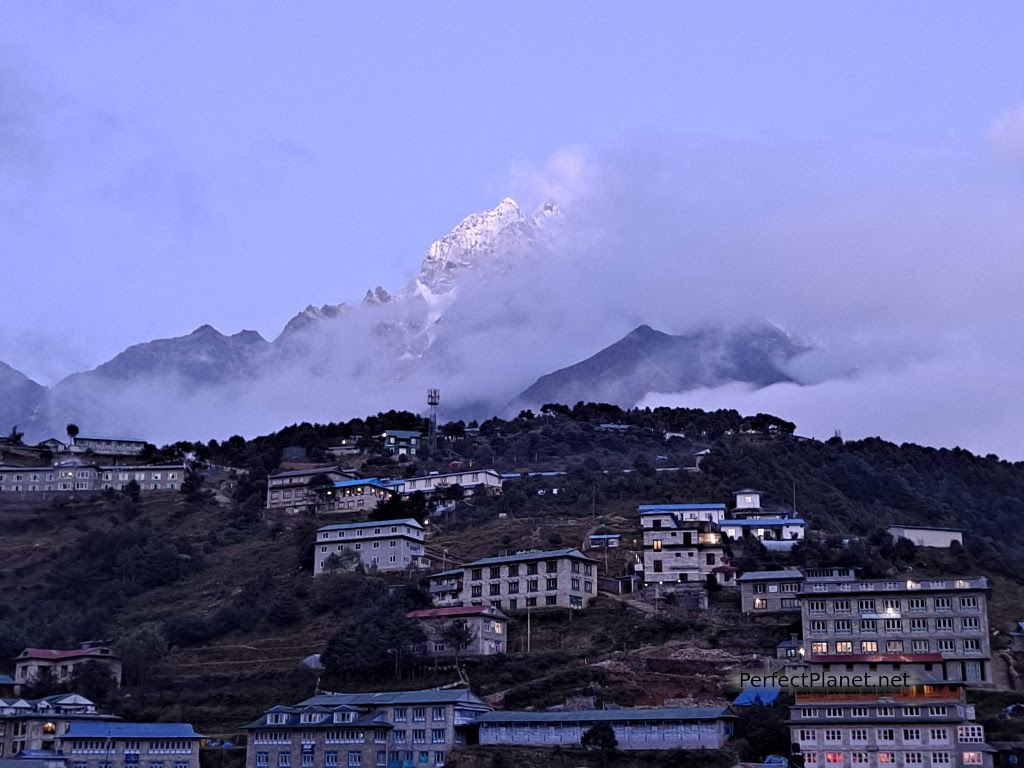
Kangtega
Circular route through the Gokyo Valley (12-15 days). The route starts in Lukla and is the same up to Namche Bazaar. As it is circular from this point you have the option of continuing the classic route to EBC and returning to Lobuche and turning off towards the Gokyo area or starting from Namche to Dole (4,150 metres), Machermo (4,400 metres), Gokyo (4,800 metres), Gokyo Ri (5,357 metres), Dzongla through Cho La (5,420 metres), Lobuche and Gorakshep. Our friends Eva and Ruben did it in 2022 and recommend the second option to return by the classic route.
Circular route of the three passes (17-20 days). The route starts in Lukla and as it is circular it can be done in both directions, i.e. the classic route first or in reverse. From Namche to Thame (3,820m), then crossing Renjo La (5,360m) to Gokyo Ri (5,357m), from Gokyo via Cho La (5,420m) to Lobuche, Gorakshep, EBC, Kala Pathar, Kongma La (5,535m) Dingboche and return via the classic route to Lukla.
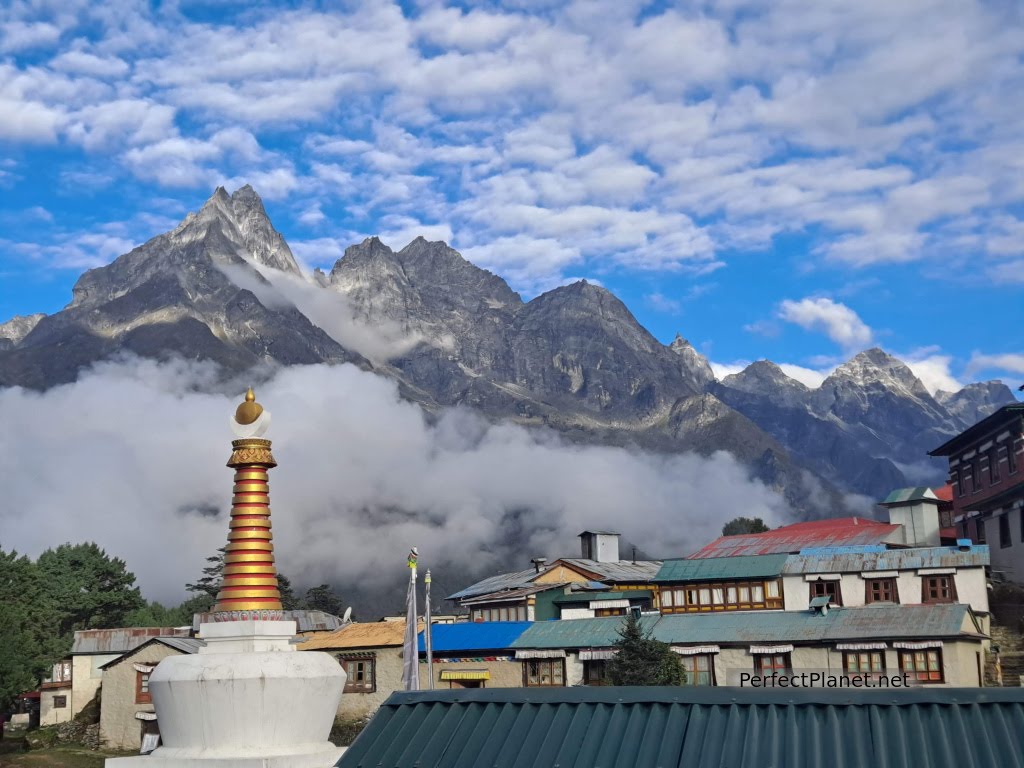
Tengboche
Trekking backpack to EBC trek, the essentials
Organising your backpack correctly is one of the most important things when preparing for a trek. It is advisable not to carry more than 10-15% of your weight (maximum 10-11 kilos), in our case we hired a porter (Chiiring) due to Joaquín's back problems, to whom we gave a 60 litre backpack with 12 kilos.
We would carry a 30 litre backpack each, Joaquín would carry 3-4 kilos and I would carry 7 kilos. Keep in mind that you have to add at least two litres of water per day to all the weight you carry.
It is not necessary to carry different clothes for each day, you can always wash them and even (this sounds crazy) repeat with the same clothes for several days. It is advisable to keep everything you carry in your rucksack in watertight bags, it is more practical and always tidier.
Weight matters a lot, and even more so with your height, selecting the right clothing and equipment is fundamental, so here are some tips that we hope will help you.
Sleeping bag. An essential element that you can't forget to bring is a suitable sleeping bag. When it comes to choosing a sleeping bag, it's important that it's compact in size and weight, as there's not a lot of room in your rucksack.
We took one with a comfort temperature of -10 degrees and we even got hot. MILLET light down sleeping bag weight 1.260 grams and dimensions 30cmx25cm compressed. Price 270€/piece.
It is very important to take into account the time of the year in which you make the trip, remember that in October and December the days are clearer but the night temperature can drop to 10 degrees below zero. In our case, in September, the temperature did not drop below -1. In each lodge room you will be provided with a blanket or duvet.
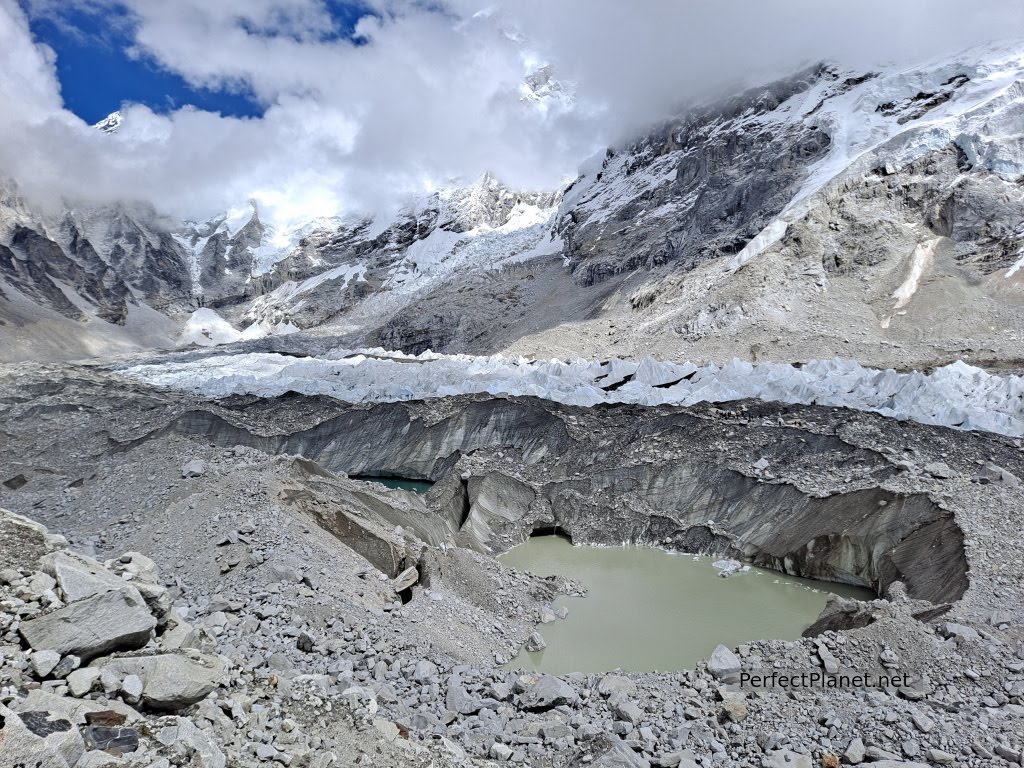
EBC
Underwear. It is enough with 3 or 4 easy to dry clothes. Remember that you can wash and dry them on the acclimatisation days and if not you can always carry them hanging from your rucksack.
Socks. We take 4 pairs, two winter and two summer for the first and last stages.
T-shirts. Weight is important, and the less you carry the better, we even weigh each of the garments to choose the lightest ones. Two short-sleeved T-shirts and two or three long-sleeved thermal T-shirts would be perfect.
Trousers. A pair of detachable trousers for the first few days, a thermal sleeping bag, a pair of rain trousers and a pair of winter trousers.
Warm clothing. A fleece and a pullover as a first layer. I also carried a shoftsell waistcoat, which is light and handy and I always find it very useful. As an outer layer, a down jacket for the coldest days and for the moments of rest in the lodges (remember that there is no heating in the rooms and the dining room only turns on the cooker when strictly necessary) and a goretex to protect you from the rain and wind.
We also took a rain poncho to cover the backpack, if it rains on the last day like us and you have to walk for 7-8 hours the poncho is the best option.
Gloves, visor, neck warmer, polarized sunglasses and hat are other essentials in your backpack. As for gloves, we carry two pairs, one thinner and the other thicker, waterproof winter gloves.
A woollen hat and neck warmer are very important as a very high percentage of body heat is lost through the head. From 4,000 metres upwards you will practically have it tattooed on your head, even when you sleep. Don't forget a visor to protect you from the sun for the first few days.
If your sunglasses are polarised or with category 4 filters, the better. The strength of the sun is more intense the higher you get, so it is essential to be well protected.
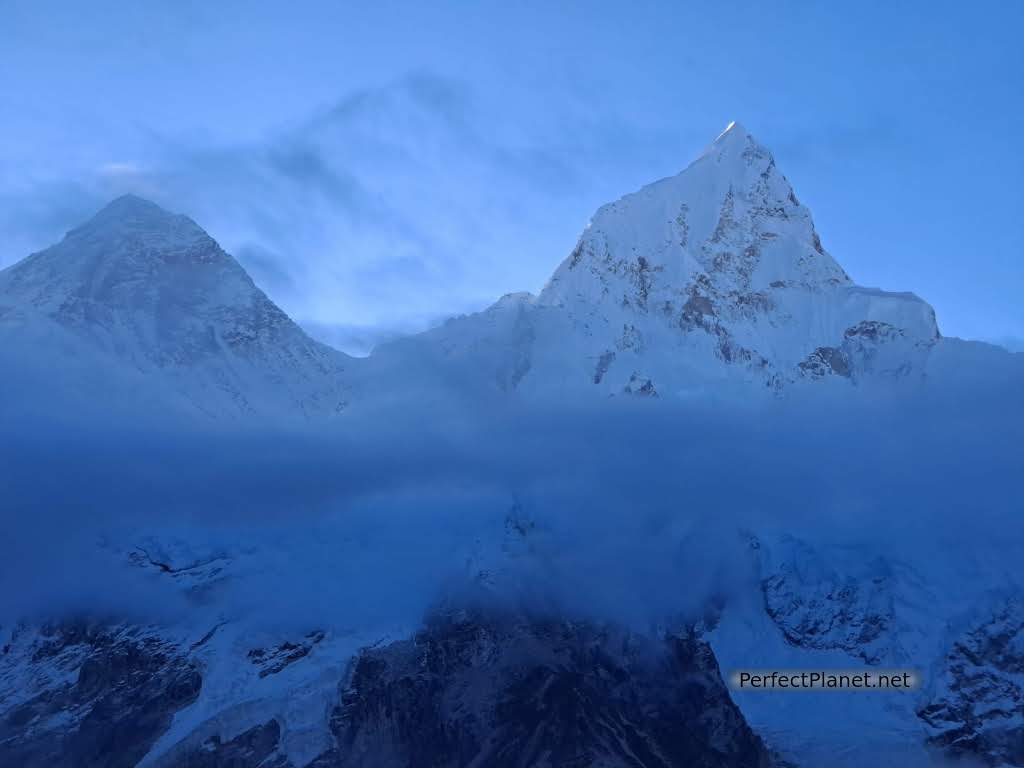
Everest y Nuptse
Footwear. For us the best option is always a waterproof boot. Although we saw people in trainers, a soft boot with goretex is perfect for the trek and avoids possible ankle sprains.
We also recommend that you take a second pair of shoes, a pair of shower flip-flops would be enough, for resting in the lodge after the day's trek.
Never wear new or recently bought footwear, as chafing can play tricks on you.
Hiking poles. In our case we take them everywhere, so although they are not essential for us they are highly recommended.
Foldable backpack. If you are carrying all the weight during the trek it is advisable to carry a smaller folding rucksack for the acclimatisation days.
Hygiene. Don't forget to bring a towel, shower gel, toilet paper and wet wipes for the times when you can't shower.
A shower in Namche is around 500 rupees/pax but in Dingboche it can cost up to 800 rupees/pax. Apart from the fact that it is not advisable to take a shower above 3,400 metres, you have to take into account that the bottles (well, everything in general) are carried on the back of the porters and you have to pay for that.
We also carry a bar of soap for washing clothes, a small rope and clothes pegs.
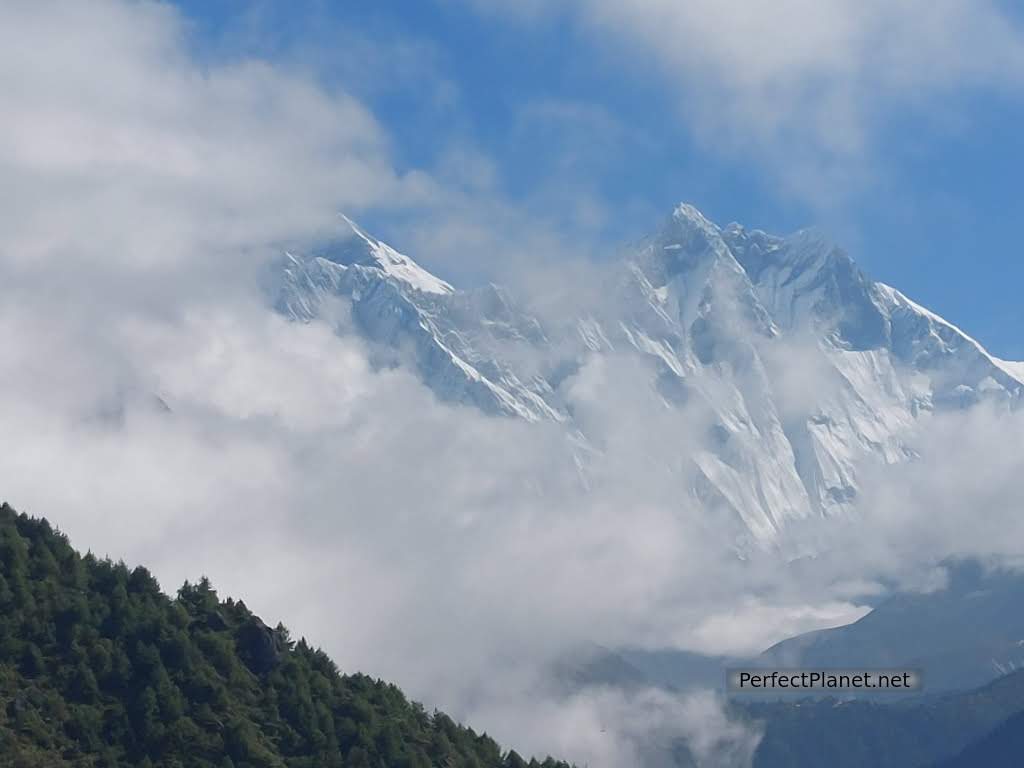
Everest y Lhotse
Batteries and electronic devices. The higher the altitude, the more expensive it is to recharge mobile phones and batteries. Some lodges even charge by the hour, with prices ranging from 200 to 800 rupees per device. Be aware that electricity in most places depends on solar panels and sometimes they do not have enough capacity. We recommend that you bring a multi-charge battery to make it more economical.
Wifi is available in most accommodations but you will have to pay for it. The higher you climb, the less likely it will work even if you have paid for it, so it is advisable to take a card to complement the Namaste, which has data up to 4,000 metres, and to complement it with an Everestlink for higher altitudes. In our case we only paid for wifi in Dingboche 500 rupees/day. Up to Tengboche we had no data problems with the Namaste card.
Remember that you can buy and/or rent the bag as well as any of the clothes or equipment you need in Thamel.
Toilet bag. Include toothbrush and toothpaste, a gel, deodorant, wet wipes and toilet paper.
First aid kit. Although our guide carried a small first aid kit, it is essential to carry one. In fact, we always take it with us on any mountain outing, so on the trek we knew we had to take it with us.
High-spectrum antibiotics, analgesics, anti-inflammatories, antibiotic ointment, betadine, plasters, gauze, adhesive tape, bandages, ankle brace, syringe, probiotics, water purification tablets, scissors, tweezers, thermal blanket, small bar of soap, tiger balm, sun cream (always 50+ or total sunscreen), oral rehydration salts, fortasec, diamox.
This last medicine is used to treat altitude sickness in its mildest phase. It is a diuretic containing the active ingredient acetazolamide, which prevents oedema in the body.
In Spain it is not easy to get a prescription from your doctor, but in Nepal you can get it in any pharmacy in Thamel in Kathmandu. The price is not the same in all pharmacies and they sell them in blister packs, not boxes, so we recommend that you ask in several pharmacies to find out if the price is correct.
We think it is necessary to take diamox or a similar medicine in case you need it, but don't do like many people who start taking it in Kathmandu, it won't get rid of altitude sickness and can have undesirable consequences.
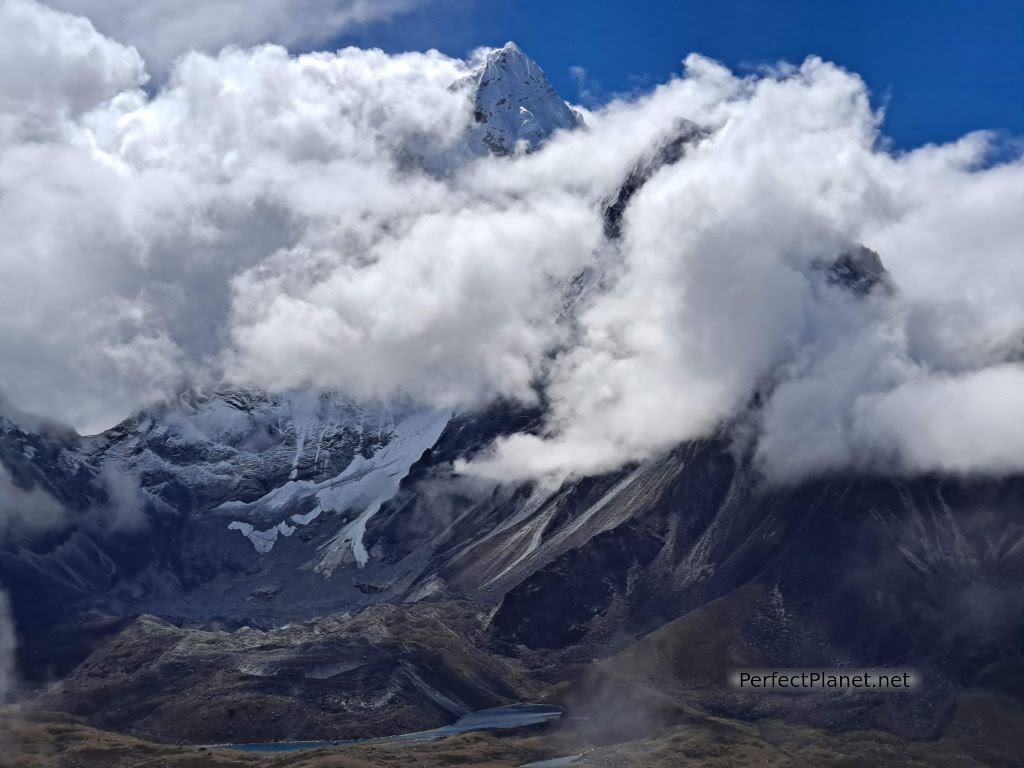
Ama Dablam
Altitude sickness
Altitude sickness or acute mountain sickness is caused by a lack of oxygen at high altitudes, the symptoms of which usually start to become noticeable from 3,000 metres above sea level. Symptoms include headache, tiredness, nausea or loss of appetite, irritability and in more severe cases, difficulty breathing, confusion, coma and even death.
Altitude sickness is no joke, the best remedy to avoid it is to descend as fast as possible, in many cases a mule or helicopter can save your life.
Taking diamox or other medication containing acetazolamide does not mean that altitude sickness will not manifest itself and it is not advisable to take it if it is not strictly necessary, the side effects are very numerous and dangerous, from a simple tingling in the hands and feet to spots on the skin.
Suffering from altitude sickness does not depend on your fitness, it will depend on your degree of adaptation. Drinking a lot of water (up to 3-4 litres a day) helps (at first we didn't believe it), not overexerting yourself, walking slowly (vistari vistari as they say), not taking a shower (it sounds crazy) from 3,000 metres (especially the head), not breathing through your mouth and covering the back of your neck when the air is very cold are some of the tips that our guide Sonam gave us and are essential to have a good trek.
Tips for a good acclimatization. Good acclimatisation is achieved by drinking plenty of water, walking slowly without getting tired, not climbing more than 500 metres per stage above 3,400 metres and always sleeping below the maximum altitude you have reached that day.
You may be interested in Budgeting for the EBC trek, tips for saving money
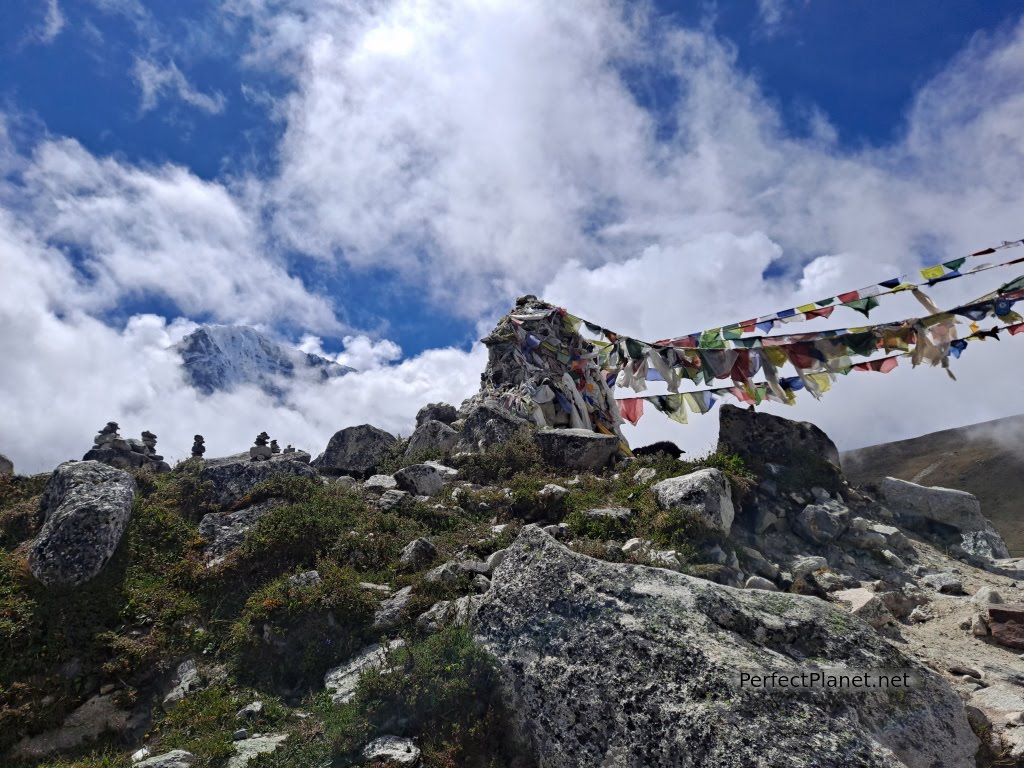
Thukla Pass
- Log in to post comments

